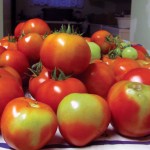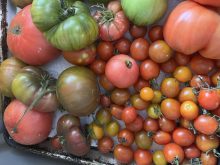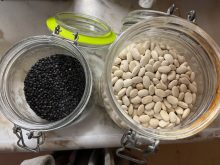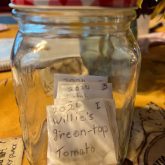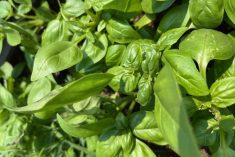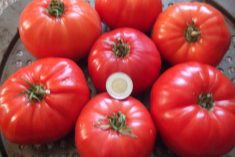Does that sound a bit like a spoken jingle when you read it out loud? Use your imagination for a moment. Let’s pretend we’ve gathered together in the greenhouse where it’s nice and warm and are enjoying a cup of energy tea. You’ve caught me sippin’ on a cup of energizing organic Cardamom Chai loose-leaf tea that I bought at Scoop and Save. It’s good stuff in my opinion. Ingredients such as green yerba maté, cinnamon, cardamom, nutmeg, ginger, clove, chicory and black pepper are blended by Common Sense Natural Products in Winnipeg — phone (204) 237-7909.
Read Also

Maintain motion to ease joint stiffness
As we proceed into colder, drier temperatures, it’s common to hear reports of more joint stiffness and pain, athletic therapist Kathlyn Hossack writes.
On New Year’s Eve
… I sang “Happy New Year All” to a neighbour down the street who made wine with grapes I grew. We toasted one another, had a slice of Christmas cake and then I sang my tomato song — “O It Must Be the Tomatoes.” It’s my musical approach to promoting prostate awareness, health and wellness among menfolk and a clue to the direction I’m headed with this first Singing Gardener page for 2014.
A reminder to all men
Please be certain to get your prostate checked once you’ve hit the age of 45 or 50. Most men don’t think about their prostate until they begin to experience symptoms such as an urgent need to pee and frequent urinary visits to the bathroom. These can be telltale signs of an enlarged prostate (BPH benign prostatic hyperplasia) or prostatitis (an inflamed prostate). Both are common conditions affecting many older fellas. Prostate health may also be connected to other issues too such as fertility and erectile dysfunction. Approximately one in three guys over age 45 has or will have prostate problems to some degree in their lifetime. Let your doctor guide you if you’re in the age bracket indicated, or show symptoms.
A well-balanced diet
… goes a long way to maintaining a healthy prostate and should include four to five servings of home-canned and stewed tomatoes weekly. Cooked tomatoes release a lot more antioxidants including lycopene from under the skin, than do raw tomatoes. As a bonus just before serving stir in a few drops of canola, flax, almond, walnut or hemp seed oil.
Excerpts from an email
Tom Stewart and his wife Esther live near Mervin, Sask. Tom writes: What causes tomatoes with white streaks and tomatoes that don’t ripen properly? They have a hard white core through the middle. The flavour is diminished, somewhat like store-bought unripe tomatoes. They were grown in the greenhouse and most have turned out this way. Tomatoes grown in the garden were OK. Wondered if it was a disease or a nutrient deficiency? I would like to hear your thoughts on it. Please see the pictures attached. I noticed the leaves had a lot of spots on them. Also it seemed to take a long time for the fruit to set. The plants were Early Girl. A cherry-type tomato (Super Sweet 100s) was not affected with the problem. Of curiosity we have had at times seeds that sprouted inside the tomato and wondered why? We live on a farm near Mervin, Saskatchewan, about an hour NW of North Battleford.
Ted’s response: As much as Canadians love tomatoes, these bold fruits of the vine are not native to Canada and have been described as the “Shivering Immigrant.” Tomato plants love heat and trace their family tree to hot weather and long growing seasons of Central and South America. Our goal is to try and provide similar conditions as best we can with growing sites that are sheltered, consistently hot and sunny during the day and warm at night. A constant airflow circulating among tomato plants allows foliage to dry off quickly after rainfall and is critical in preventing diseases.
In addition, a couple inches of wood chips mulch spread over the entire area and around each tomato plant retains moisture and cuts down on need for watering. Wood chips are a good investment and can be raked off into a pile at season’s end for future use. Less expensive mulching can also be achieved by spreading several thicknesses of newspaper over soil and placing dry grass clippings or oat straw on top.
-
These leaves on a greenhouse-grown tomato plant are letting the gardener know that something isn’t just right. The problem appears to be septoria leaf spot, a fungus that begins as yellow dots that quickly turns into brown zones surrounded by yellow halos. Infected leaves turn completely brown, collapse, dry up and should be removed at once to prevent spread of the disease. Such plants must never be taken to the outdoor tomato garden. Some best choices for greenhouse growing are Buffalo, Caruso and Cobra.
photo: Ted Meseyton
-
Shown are tomatoes with greenish-yellow shoulders instead of a solid red. It’s called ‘tomato yellow shoulder disorder’ and is associated with adverse weather and cultural practices. It’s natural for some varieties including hybrids, old-timer, heirloom and heritage tomatoes to have ridges, stripes, green cheeks and other unusual markings. What they lack in appearance is often compensated for by true tomato taste. Note the recessed brown bacterial spots on the tomato at forefront (right side) that become scab- like. Severity increases when fruits and foliage are exposed to wetness.
photo: Ted Meseyton
Do you ever feel stressed?
Well so do tomatoes. Avoid planting them out too soon. They dislike extreme variables between daytime and night temperatures. Fluctuations in temps. and weather extremes disturb a tomato’s ripening process leaving fruits susceptible to uneven ripening and developing hard central cores. For example, it may hit 21 C or higher during daytime in May. When the overnight temperature drops below 15 C tomato problems are almost a guarantee. Wait until early to mid-June. Inside a greenhouse it can be 10 C hotter than outside leading to stickiness, stagnant air and poor ventilation. A greenhouse without roof vents can be shaded with heavy dark material. Prop doors and windows open and keep one or more fans going inside to allow constant airflow. Stressful weather and variable temps. contribute to fibrous tissue and not much tomato flavour. Interior seeds can sprout as a result of cool or hot soil and moisture stress. When growing conditions are challenged, Mother Nature prompts a tomato into survival mode causing seeds to germinate.
Tomato transplants need a week or 10 days to settle into their outdoor garden home. Side dressings of high-quality compost and organic matter are essential to maintain a fortress of healthy soil microbes. Feed plants once with all-purpose organic tomato plant food, fish emulsion or seaweed during the first month and in moderation thereafter.
If you have sufficient space, focus on growing early-, mid-season and late-ripening tomatoes and varieties well adapted to your region. Keep a record and discontinue those that don’t meet expectations. Among tomatoes shown to resist white cores are: Better Boy, Big Beef, Carnival, Celebrity, Champion, Daybreak, Mountain Fresh, Mountain Princess, Mountain Spring, Northern Exposure, Primo Red and Tasti-Lee. Slicers and juicy varieties include: Break O’ Day, Charlie’s Red Staker, Earliana, Heartland, Matchless, Pritchard’s Scarlet Topper, Sasha’s Altai, Sioux, Stone, Stupice and Valiant.
I, Ted, asked Gardener Al
… how his greenhouse tomatoes did this past summer and he responded: “Not worth a darn. It got too hot inside and there was no aeration. Good air movement is something they don’t get in the greenhouse where high humidity and dampness on foliage can lead to problems and blights. Tomatoes grow faster and better outside when roots can spread out and temperatures suit them better. I wasn’t happy at all with Celebrity and Manitoba growing in the greenhouse but they sure did well out in the garden along with Big Boy, Bush Beefsteak and Star Fire.”
To Grainews readers… How do you handle tomato issues? You’re welcome to pitch in and let us know.
This is Ted Meseyton the Singing Gardener and Grow-It Poet from Portage la Prairie, Man. There is so much more to tell about tomatoes. The subject simply can’t be adequately covered here today, so I’ll continue on the Tomato Trail next time. Also remember, I garden for food, fun and recreation. Come and join me all you men ’cross the nation, Cause we guys sure don’t need aggravation, Give the prostate a little help and appreciation. My email address is [email protected].




